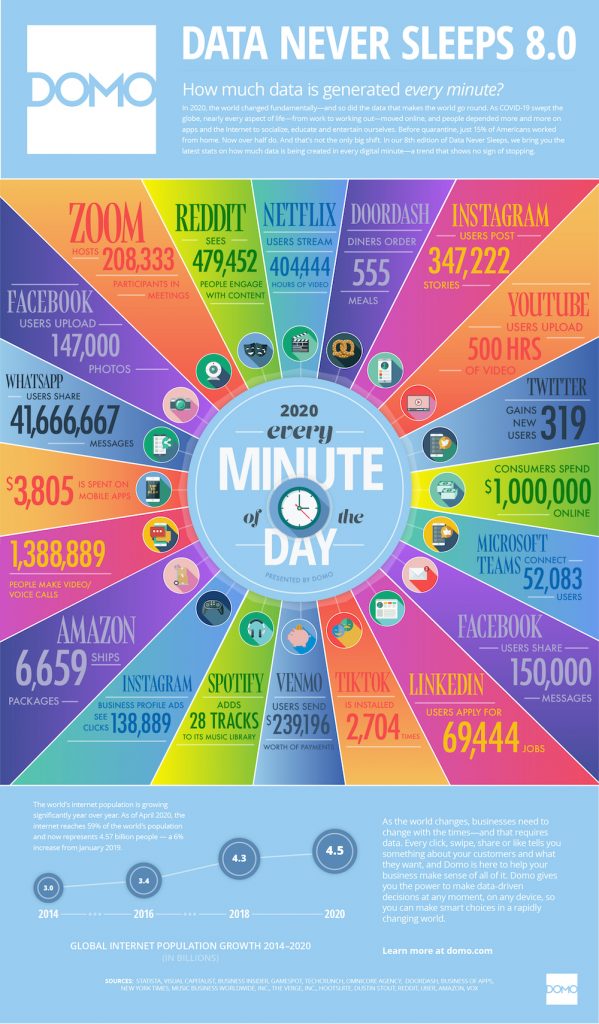
Humans create 2.5 quintillion bytes of data each day, according to Forbes. Numerically, that amount looks like:
2,500,000,000,000,000,000
That is a lot of data.
Take a look at what that means every minute of every day for in-home entertainment, virtual communications and the future of work in this graphic from Domo:

We know that good data can help us better understand target audiences, improve current strategies, and guide future decisions.
Think about data as a tool to maximize your marketing dollars. For instance, if you have a high bounce rate on your website, you may consider if your landing page is providing relevant content to visitors. Or if you know which of your social channels has the highest click-through-rate, you may focus your efforts there or consider how to improve your content on other channels.
But with so much data out there, getting started can be intimidating. Here are a few data channels to explore.
Use Data to Reach Marketing Goals
1. Social Media Analytics (Easy Level)
One of the easiest ways to begin understanding data is by using the built-in analytics tools on social media platforms. When you set up your social media accounts as a business, you already have access to insights about your page. This includes Facebook Business Manager, Instagram Insights, and Twitter Analytics.
These easy-to-understand reports measure impressions and engagement, track activity trends, and show your best-performing posts. Use these to help you understand the most effective type of content or best day and time to post.
2. Google Analytics (Moderate Level)
Once you are comfortable with some basic data terminology and reports, consider setting up a Google Analytics page for your website. By adding just a small piece of code to your webpages, Google Analytics can track all kinds of activity like how many visitors you had, how long they stayed on your site, which pages they visited most, what devices they use, and what channels directed them to your site.
Google offers free trainings that will help you set up Analytics, read data and create custom reports, and even apply those insights to your strategy.
If you are new to Google Analytics, start with the beginner course. If you understand the basic interface of the platform and how to run reports already, learn more complex analysis skills in the advanced course. The courses use a variety of teaching methods including videos, interactive demos, and knowledge checks. Each course will take approximately four to six hours and offer a certificate of completion.
3. Survey Research (Advanced Level)
If the data you are looking for is not readily available, you may consider collecting your own data through a survey. Surveys can answer more specific questions related to your business.
A simple customer satisfaction survey can reveal where you are succeeding and where you can improve your customer experience. You can get started with free surveys using Google Forms, Survey Monkey, Typeform and more.
Many of these survey tools will summarize results data for you and allow you to export the data if you want to run analytics in another software like Excel. In Excel, you can sample data, graph results, and run tests to compare means, identify correlations, forecast, and more.
Need Help Putting Your Data to Good Use?
Data may seem a little overwhelming at first, but with some simple tools and a little training, data can help you better understand your customers, improve your strategies, and reach your goals. C2 Strategic can help create data-driven creative strategies. Contact us today to get started.
— Nicole Childress, Staff Strategist
In each Tip Tuesday post, expert strategists at C2 Strategic share communications advice for better outreach and engagement on traditional and modern media channels.




